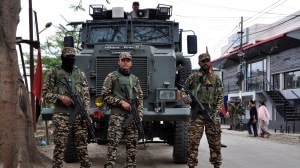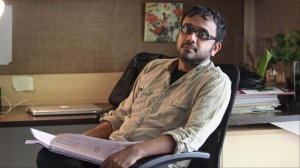- India
- International
Gorakhpur hospital tragedy: Midnight, Ward No. 100
Long before the world came to know of it, parents had named this ward of BRD Medical College, Gorakhpur, ‘mratak lok (land of dead)’. The Indian Express meet 10 families seeking hope here in that shadow
 Relatives of patients in Ward No. 100 grabbing any place in the building complex to rest for brief snatches at night, in between tending to their children.Express Photo by Vishal Srivastav
Relatives of patients in Ward No. 100 grabbing any place in the building complex to rest for brief snatches at night, in between tending to their children.Express Photo by Vishal Srivastav
AS THE clock strikes midnight on Thursday, August 17, parents and family members gathered outside Ward No. 100 of BRD Medical College, Gorakhpur, start staking out the corridors, the stairs, the portico.
They must act fast.
In hardly five minutes, all the space in this paediatric building complex — housing the beds, the hospital’s Paediatric Intensive Care Unit (PICU) as well as Neo-Natal Intensive Care Unit (NICU) — that has seen over 150 deaths so far this month, is taken. The attendants are spread out on pieces of cloth and plastic that they have fished out. Just long enough and wide enough to hold them. Others lean against paan-stained walls.
Sleep is another matter though. Most are here in pairs, and take turns attending to their children. All through the night, they keep getting up to relieve the other, or to peek inside through the glass walls of the ward’s blocks for news. Inside, the attendants stand, or perch themselves on beds being already shared by two children in many cases. At night, there are on an average one doctor and one nurse plus two paramedics in each of the blocks, with 12 beds each, that the ward is divided into.
The heat and humidity are oppressive, the only thing stirring the still air are a few hand-held fans being wielded by weary hands and the faint cries of infants that travel outside.
Around 2.15 am, there is welcome relief. A boy in his early 20s has entered the ward premises, carrying a huge kettle. As he shouts out “chaaiii…”, parents rush for the Rs 5 “masala aur nimbu” tea. It is partly to fight sleep, partly to quench hunger (most had their last meal at 7 or 8 pm, in the private canteens that have sprung up on the hospital campus).

As they sip the tea gratefully, a parent helpfully tells another he can find a used plastic sheet to sleep near the rain basera (night shelter) for just Rs 20.
An hour later, the tea boy returns, expecting to find more customers. But before he can say anything, the peace of the night is broken by the sound of loud crying. All those who hear know without being told what has happened, and where. Some lie back down, others watch in silence as a young man comes down minutes later from the NICU on the first floor and walks past carrying what looks like a newborn in a pink colour towel.
Over 50 per cent of the deaths taking place in Ward No. 100 are NICU deaths, though the government has denied that any of these deaths were related to shortage of oxygen supply, which the hospital faced on August 10 and 11.
While the father of the dead infant is stunned into silence, a woman who identifies herself as Asha and his aunt says the boy was delivered just an hour back at a hospital in Brahmpur block of Gorakhpur. Since he had difficulty breathing and the hospital did not have a ventilator, the infant was referred to BRD Medical College. He was dead by the time he reached.
To provide better health facilities and reduce the large number of deaths of children in the region, the Uttar Pradesh government had allotted Rs 18 crore for construction of a ‘100-bed new ward’ at Baba Raghav Das Medical College, Gorakhpur, six years ago.
Ward No. 100, so called for its 100 beds, is that ward. It’s also called ‘Mastishk Jwar or Brain Fever’ (as it treats mostly encephalitis cases) ward. Long before the night the country’s attention was drawn to it, parents like the one here this Thursday night started calling it by another name: ‘Mratak lok (place of the dead)’.
For most of them, BRD Medical College is not their first option. But, they fear, it could be their last. Tonight too, there will be deaths — between noon on August 17 and noon August 18, nine died in the ward, hospital records will later show. Five in NICU, four in PICU, at least two due to acute encephalitis syndrome (AES).
***
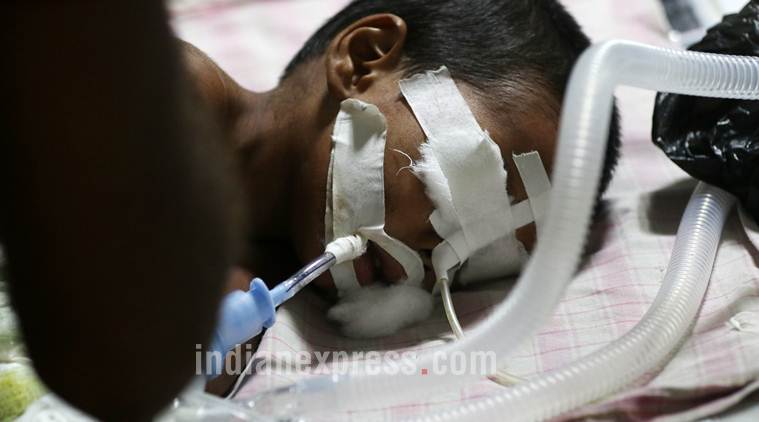 The five-year-old has AES, and is in the hospital since August 14. Shamim keeps sponging her to bring the fever down. Express Photo by Vishal Srivastav
The five-year-old has AES, and is in the hospital since August 14. Shamim keeps sponging her to bring the fever down. Express Photo by Vishal Srivastav
Roshantara, 5
Siwan, Bihar
Father Shamim makes around Rs 7,000 per month from a small agricultural plot
At 12.20 am, Shamim, 34, comes out limping from the NICU. Rushing towards the end of the corridor, he fills water in a green plastic tumbler from an overflowing washbasin. A vendor offers him tea, but Shamim brushes him away: “Kuchch khana peena nahin hai (I don’t want anything to eat or drink).” He rushes back to Roshantara.
The five-year-old has AES, with high-grade fever, headache, nausea and convulsions. Shamim says they came on August 14 from Siwan, 130 km away, due to “lack of facilities” in the district. “I have another daughter, who is one. Her mother has to take care of her. I have come alone with my daughter. The doctors visit once an hour. That is the best a poor man can ask,” says Shamim.
He takes out a piece of cloth, dips it in the tumbler of water and uses it to sponge Roshantara. With just one nurse and doctor around, Shamim, like most of the attendants inside, are on their own.
The washbasin from where Shamim collected the water has a handle broken and is filled with waste that people have thrown in. The three dustbins inside the ward premises, next to the toilet and right adjacent to the ward, are also overflowing, including with biomedical waste.
Shamim hasn’t given a thought to all the germs he may have brought back in his dash to the washbasin. An ICU dealing with encephalitis patients is mandated to only use disinfected water. There is no hand sanitiser around, and none of the attendants are wearing any isolation gowns, masks, gloves or shoe covers, which is also a must in ICUs as per the National Centre for Disease Control.
Roshantara is sleeping on a plastic sheet, spread over the bed, bought by her father for Rs 20. The same is true for almost all the children in the block. Urinary tract infection is a common infection acquired by children inside ICU, and using sanitised bedspreads is one way to prevent it.
***
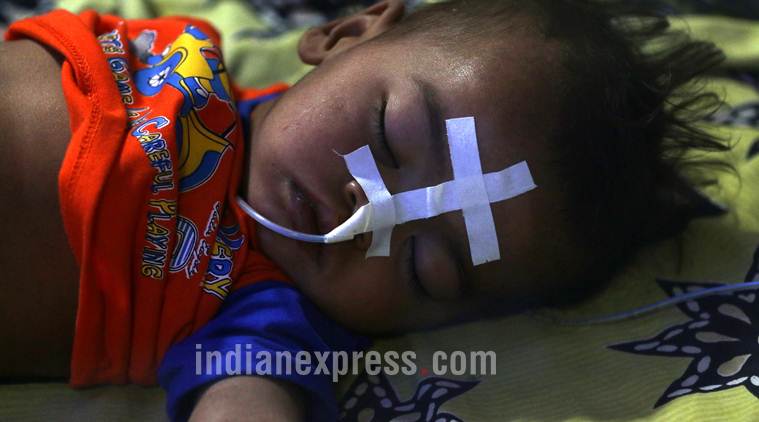 The family, scared of BRD after the deaths, put off bringing Aman here. Till the private doctor said he was helpless. He came on August 16. Express Photo by Vishal Srivastav
The family, scared of BRD after the deaths, put off bringing Aman here. Till the private doctor said he was helpless. He came on August 16. Express Photo by Vishal Srivastav
Aman, 1
Nahar Chapra village, Padrauna, Kushinagar district
Shriram Kushwaha, a labourer on construction sites, earns about Rs 6000-9000 a month
When 13-month-old Aman developed rashes last Saturday, the first person his family approached was a quack in the neighbouring market, who did jhar-phoonk, told them that his condition was due to “devi naraj”, and asked them to wait till the spirit’s anger subsided.
It was only when the child began having convulsions that they took him to a private doctor in Kushinagar town, about 18 km from their village. When Aman’s deteriorated further, the doctor asked the family to take him to a facility with better medical care.
Aman’s father Shriram Kushwaha says he had heard of the deaths and hence was reluctant to bring the child to Gorakhpur initially, but gave in after the private doctor expressed helplessness. “Jab jhatka khane laga to ghabra gaya sab log. Yahan nahin to kaha jate?… Wahan se private bus kiya, do hazar rupey udhari liya… aur char ghanta chalke medical aaya (When the child began having seizures, we got scared. Where else we could have gone if not here?… We then took a private bus, borrowed Rs 2,000 and got here after a four-hour journey),” says Shriram, who reached Gorakhpur on August 16.
Doctors have told the family that Aman’s condition is stable but are not sure of what ails him.
It’s 3 am in the morning when Shriram wakes up wife Indrawati, who is sleeping on a plastic sheet in the corridor, to ask her to sponge the child. Indrawati has slept for just two hours.
“Yahan to yahi jindagi hai, khana khane ka samay bhi nahin mil pata (This is our routine here. We do not get time for even food),” she says.
***
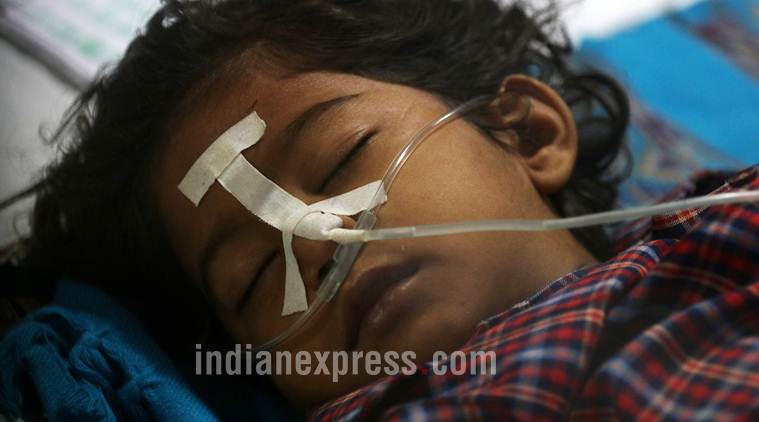 Brought to BRD on August 14, she is unable to recognise anyone. Her father doesn’t have the courage to face her. Express Photo by Vishal Srivastav
Brought to BRD on August 14, she is unable to recognise anyone. Her father doesn’t have the courage to face her. Express Photo by Vishal Srivastav
Aradhya, 5
Rampur village, Gorakhpur
Father Bhupendar works in Delhi at a paper factory, earning 1,000 per month
Aradhna’s aunt Anupa says Bhupendar won’t enter her room in Ward No. 100.
“He is very weak-hearted. Aradhya is still not recognising anyone, and her father is not able to handle it. He sits outside the whole day but won’t enter. Only this evening she drank some milk. Doctors say she will start responding tomorrow,” says Anupa. Aradhya’s mother couldn’t come as she is expecting another child.
The Uttar Pradesh government claims that almost 80 per cent of its children have been successfully vaccinated. Not Aradhya, says Bhupendar. No health worker ever visited the girl. The primary health centre (PHC) in their village Rampur has been “locked since years”, he says.
Apart from Anura, Aradhya’s uncle Jitender (Bhupendar’s younger brother) takes care of the girl inside the ward. With Bhupendar away in Delhi working, it is Jitender who had rushed Aradhya to a private hospital near the Gorakhnath temple when she fell ill.
When the doctor said he couldn’t help, on August 14, they came to BRD.
At 3.30 am, Jitender comes out of the ward for a brief break, and bursts into tears. “Aradhya is the most loved person in the family. She was born eight years after my brother’s marriage. I am married but I still don’t have children. She is the only child of our family. We just pray that everything returns to normal,” says the 28-year-old.
But what is normal, he goes on to ask. “It is only here that we came to know there is a vaccination to prevent such fever (acute encephalitis syndrome). No health worker ever came to us for any vaccination or immunisation. Our PHC is shut for years. I feel cheated by the government.”
***
 Astha has been in and out of hospital since birth. She came to BRD on August 11, soon after the string of child deaths. Express Photo by Vishal Srivastav
Astha has been in and out of hospital since birth. She came to BRD on August 11, soon after the string of child deaths. Express Photo by Vishal Srivastav
Astha, 17 months
Bahai village, Sant Kabir Nagar district, UP
Father Ram Shankar Mishra, a priest, earns Rs 3,000-Rs 6,000 a month
Sitting beside granddaughter Astha and constantly fending off sleep, Dheerendra Prasad Mishra, 60, has his eyes on the monitor that keeps track of her vital signs.
It’s 1 am and Dheerendra’s turn to ensure that the infant, currently on life support, does not disturb the oxygen pipe supporting her, with her hands. Astha’s parents, father Ram Shankar Mishra, a priest at their village in Sant Kabir Nagar, and mother Anju, had been nursing her the entire day but have just found place to rest in the corridor, adjacent to the pharmacy of the ward.
Since her birth, about a month and a half ago, Astha has spent most of her time in hospitals. Ravi Shankar, who arrives to relieve his father at 2 am, says she was just four days old when she began having difficulty breathing and appeared to have congestion in her chest.
Shankar says he first took Astha to the district hospital in Sant Kabir Nagar where she was born, before shuttling her between two private doctors.
He says that one of the doctors told him that she had pneumonia, while the other said water had entered her mouth during delivery. With her condition deteriorating, doctors asked him to shift her to Gorakhpur, about 37 km from their village.
The family landed here on the morning of August 11, when the death toll of 30 in two days set off alarm bells. Doctors here confirmed that she had pneumonia and put her on life support.
Over the past few days, Ram Shankar says he’s watched bodies of children being taken away. “Yeh Mritak lok hai, dar lagta hai roj marte hue bachon ko dekh kar. Par aur kahan jayen. Lucknow dhaisau kilometre door hai (This is a place of the dead. I get afraid watching so many children die each day. But where can we go? Lucknow is over 250 km away),” he says.
***
Ankur, 14
Padawna, Kushinagar
Father Ram Swarup Singh works as a painter in Riyadh, earning Rs 20,000 a month
For five hours now, Ankur, shivering from high fever and bouts of seizures, has been lying wrapped in bedsheets. At 12.30 midnight, six hours after he arrived at BRD, he is finally shifted to the NICU.
Mother Reena says they knocked at the door of two hospitals before being referred to BRD. They have been asking the nursing staff for a blanket, but there is none to keep Ankur warm. They also hope a doctor would come soon to settle their fears. “Yeh Japani bukhaar hai kya? Private doctor keh raha tha ki sirf khoon kam hai. Phir aise kyun tadap raha hai (What is this Japanese Encephalitis? The private doctor had said it’s only anaemia. Then why is he is in such pain?)” Reena asks.
Inside the ward, every patient admitted is labelled to be suffering from the loosely used term ‘AES’. But very little or nothing is shared with the parents on the trigger behind the inflammatory brain disease. A doctor has told Ankur’s family “loss of blood supply” could be the reason for his disease.
Tests show Ankur’s haemoglobin levels are as low as 3g/dl, which is not a surprise, say doctors. An overwhelming number of patients at BRD are from low-income groups and have poor nutrition levels. Ankur had been first diagnosed as anaemic two years back too. Now he has again fallen ill, but this time with high fever and sudden seizures. “This has never happened,” says his uncle Ram Badan Singh, who works as a plumber in Mumbai.
Chief Minister Yogi Adityanath has blamed dirty water and sanitation for the encephalitis cases. Ram Badan shrugs when asked if there is a toilet in their village Padawna. “No. All of use the fields,” he says.
***
Manjesh, 4
Pokharbhinda village, Darbhanga
Father Suraj works as a daily wage labourer, earning Rs 5,000 a month
Manjesh occupies the bed next to Ankur’s. His father says he can “understand the fears of Ankur’s family”.
The four-year-old from Pokharbhinda village in Darbhanga, 320 km away, was also diagnosed as being anaemic when admitted two days back, but is now being treated for AES.
While Manjesh is recovering, Suraj also gives the example of his elder son Anikesh, 6, who was wrongly diagnosed, three years back. Anikesh is now partly paralysed and cannot walk. “When he was 3, he had similar symptoms, fever followed by seizures. We rushed him to Metro Hospital in Gorakhpur. They admitted him for three days and then said he is fit to be discharged. Within a few days, he started becoming disoriented and confused and again the seizures followed. By that time, things were out of control,” Suraj says.
“Doctors tell you very little even as parents watch all of it happening before their eyes. I later came to know that my other son suffered from encephalitis. I understand the fear of the patients who come here for the first time,” Suraj says, offering help to Ram Swarup.
***
Akhilesh, 5
Chembur, Mumbai
Father Tulsi Prasad works with Hindustan Petroleum and earns Rs 20,000 a month
Akhilesh fell sick a week ago, when he mistakenly consumed a few drops of kerosene. “My father passed away last week, so we were visiting our village in Kushinagar for the rituals. By mistake, Akhilesh consumed kerosene lying in the kitchen. We took him to a local doctor and he said there is nothing to worry,” says Tulsi Prasad.
He hopes against hope that this is the cause for the five-year-old’s high fever and seizures. “We have no clue what is the reason. He was alright and suddenly now he has seizures,” the father says.
Inside, mother Rajkumari tries to sponge Akhilesh with one hand, while ensuring he doesn’t pull his ventilator tubes, with the other. She isn’t sure kerosene is responsible, she says. “These are just bad times for the family. My son is affected because of that. Why is he acting so disoriented? He has slept for only two hours.”
Pregnant, she also worries for her unborn child. “I’ve had to visit a doctor, I am not able to walk, it is just a bad time for us,” she adds.
***
Swajeet Kumar, 3 years
Bhatahat village, Gorakhpur
Father Chunmun Kumar, a ceramic tiles fitter, earns Rs 8,000-Rs 10,000 a month
Chunmun and wife Sarita have eaten little since doctors asked them to sign a paper indicating that the condition of their son Swajeet, ailing now for 20 days, was serious. Doctors also said he may need blood transfusion. Swajeet was admitted to Ward No. 100 on August 11, the day news of the other deaths broke. Chunmun, who witnessed the chaos due to oxygen shortage, says he was handed an ambu bag (manually inflated bag) for his son as he wasn’t breathing properly.
Chunmun, a father of four, and Sarita take turns to sleep during the day, when doctors and nurses are constantly available, but stay awake all night. Since Adityanath’s visit and the media coverage, things have “become better” at the hospital, Chunmun says. “I came here earlier with someone else but back then, we had to get medicines and tests done from outside. Not this time.”
***
Mohammad, 10 weeks
Khalilabad, Sant Kabir Nagar district
Father Imran, who runs a small confectionery shop in the village, earns about Rs 5,000 a month
Sitting on the floor just outside the PICU, Mohammad’s father Imran is holding his head. He has just been jolted out of sleep by a father carrying the body of his newly born child, with crying relatives in tow.
“We came here three days ago. Mohammad was running a high fever and having difficulty breathing. He began having fits too,” says Imran, adding that that a private hospital in Gorakhpur refused to admit his son. Imran says he didn’t bother visiting either the government hospital in the district or the closest primary health centre. “We were not sure if we would find anyone there. They don’t have paediatricians there either,” he says.
Imran’s father Shah Alam says doctors have told them Mohammad is suffering from serious congestion. Having watched children die on beds next to Mohammad’s, Imran says, “It is traumatic, but what do you do? As I said, for us there is no other place.”
***
Arohi, 1
Chamukha village, Gopalganj, Bihar
Father Pradeep Kushwaha, a farmer, earns Rs 6,000-Rs 7,000 a month
It’s 4:30 am and Pradeep Kushwaha comes running to wife Sapna, sleeping near the staircase in the gallery. With daughter Arohi’s temperature still high, the lone duty doctor wants her body to be sponged with water. “Jaldi chala (Come fast),” Pradeep tells his wife, directing her to PICU, where Arohi is admitted.
The couple and Pradeep’s parents, father Manager Prasad and mother, have been camping at the ward since August 16. Their village in Bihar’s Gopalganj is some 65 km from Gorakhpur. Manager says after his granddaughter developed fever, they first took her to a government and a private hospital in neighbouring Deoria district. “The private hospital wrongly diagnosed the child as having typhoid and began giving medicines. Her condition deteriorated,” says Manager, adding that it was only when they reached BRD that they realised Arohi’s condition had been wrongly diagnosed. Doctors have said she is stable now, but Arohi remains on life support.
***
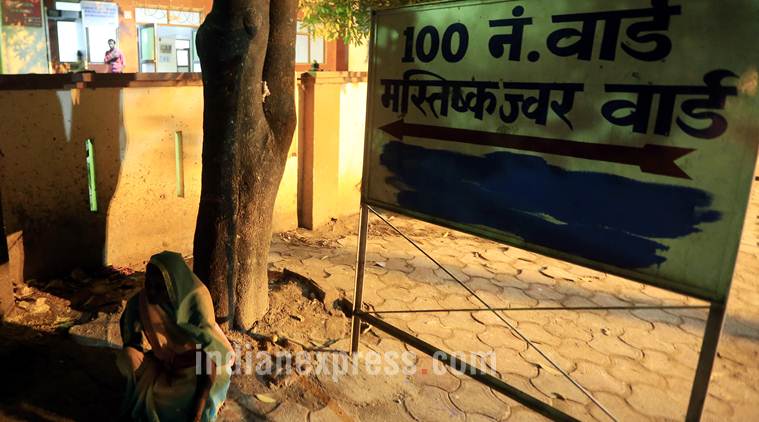 Parents say the deaths have scared them. “But where do we go?”Express Photo by Vishal Srivastav
Parents say the deaths have scared them. “But where do we go?”Express Photo by Vishal Srivastav
Standing at the entrance of Ward No. 100, Govind Prasad, 52, says he has seen it all. The only guard on duty, Prasad, who hails from Maharajganj, retired from the Army. “My last posting was in Kargil,” he says proudly.
However, there is little he has seen more painful than the deaths at this ward, he sighs. “I have been working here for seven years under the NRHM (National Rural Health Mission). I was a strong man when I was in the Army. But children dying and in such numbers is very painful. There have been times when things have gone out of control,” says Prasad.
What happened this year was bad, he adds, but not the worst. “Two years back, the situation here was worse. At one point, there were no beds and children waited endlessly outside the ward. Some would die just because of the burden and delay.”
Apr 24: Latest News
- 01
- 02
- 03
- 04
- 05
















